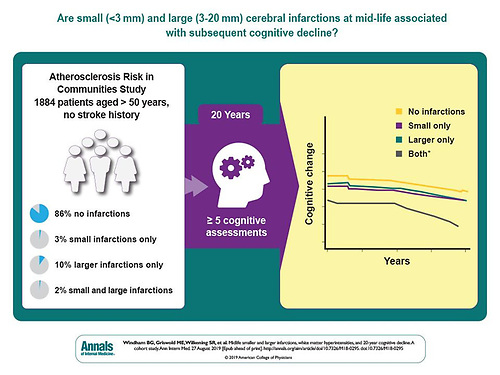Small, large lesion pairing accelerates cognitive decline
A set of lesions the size of pinheads seem like they couldn’t do much damage. For decades, physicians thought the same. But new research from the University of Mississippi Medical Center add to the evidence than even small areas of damage can have major consequences for brain health as we age.
Published online August 27 and in print September 17 in the Annals of Internal Medicine, the study shows that having a combination of small and large infarcts in the brain is associated with substantial cognitive decline, even in people who have not had a history of a clinical stroke.

“This suggests that smaller infarcts could be much more detrimental to brain health than we previously thought,” said Dr. Gwen Windham, professor of medicine and lead author of the study.
An infarction is a lesion where tissue death has occurred because “blood supply to the tissue is lacking,” Windham said. Infarctions are a common cause of stroke, but don’t always lead to a clinical stroke.
In this study, the researchers looked for infarctions in magnetic resonance imaging scans of more than 1880 stroke-free, middle-aged adults from the Atherosclerosis Risk in Communities study, ARIC for short. They then assessed cognitive decline in the study participants over a 20-year period using a series of standard memory and language tests.
Windham and colleagues compared people with no infarctions, small infarctions of less than 3 mm, larger infarctions, and those with both small and large infarctions. This differentiation between infarct size matters, Windham said.

“Typically, radiologists will not consider infarctions to be present unless these spots are more and 3 mm in size,” Windham said. And for good reason: at less than a tenth of an inch in diameter at their largest, this size infarction can be hard to spot on an MRI.
Over the course of follow-up, people with only large or only small infarctions had comparable rates of decline, but people who had a combination of both smaller and larger infarctions at baseline had the greatest decreases in cognitive function over the 20-year period.
“Particularly, those with both smaller and larger infarctions had changes in the cognitive function scores at the end of the 20-year follow-up that would be expected over a 50-year timespan instead of only 20 years,” Windham said.
Windham notes that MRIs has advanced significantly since the participants received their initial scans in the 1990s.
“By current standards, these are crude measures of vascular disease in the brain,” Windham said. “We have better technologies today that can see infarcts better and more clearly. One future area of study could involve using the current technologies to look at neurons, vasculature, the blood brain barrier or other factors.”

“It’s increasingly clear that mid-life vascular and cerebrovascular diseases have huge influences on cognitive impairment in later life,” said Dr. Michael Griswold, biostatistics professor in the Department of Medicine and co-author of the study. “Large longitudinal cohort studies like ARIC are the best and only resources we have to tell us how early changes in the brain affect cognitive outcomes which occur many years later, like Alzheimer’s disease and dementia.”
This is one reason that The MIND, or Memory Impairment and Neurodegenerative Dementia, Center at UMMC is partnering with the Mayo Clinic in starting a new longitudinal cohort study, Griswold said.
“The MIND Center – Mayo Clinic Study of Aging will be a new resource for generating evidence on aging-related diseases for decades to come,” said Griswold, director of the MIND Center Science, Evidence and Technology Core.
Previous studies from ARIC and The MIND Center have shown that smaller infarcts can increase the risk for stroke. The current publication builds upon this work.

“Before these studies, we had no data showing that smaller infarcts had any clinical meaning, but now we have evidence that cognitive decline, stroke and stroke mortality are associated with these smaller infarcts,” said Windham, director of The MIND Center Neuroepidemiology Core.
Furthermore, Windham said that it’s possible these smaller infarction contribute to “whispering symptoms” of stroke, like brief episodes of double vision or numbness, although more research is needed to confirm this.
Dr. Thomas Mosley, Dudley & Robbie Hughes Distinguished MIND Center Chair and director of the MIND Center, says that some level of cognitive decline is common during aging.

“These changes are typically subtle and often experienced as slower processing speed or mild difficulty sustaining attention,” said Mosley, a professor of medicine and senior author of the study. “While subtle changes in thinking ability are considered part of normal aging, dementia, which involves cognitive difficulties substantial enough to impact one’s ability to carry out daily tasks, is not considered normal aging.”
Mosley says that symptoms such as repeating conversations, getting lost in familiar places, difficulty with language, judgment, comprehension or making decisions, and changes in personality are not considered normal and should be discussed with a professional.
Researchers from Wake Forest School of Medicine, Mayo Clinic, Johns Hopkins University School of Medicine and the University of Washington also contributed to the study. The ARIC study is funded by the National Institutes of Health.

